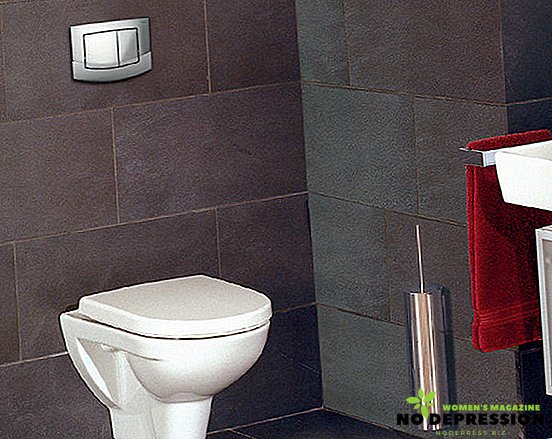In the past few years, many have chosen special toilet bowls that have a number of advantages over stationary sanitary equipment. The product itself is installed on the installation - and with its installation a lot of questions arise, because here it is important to design and calculate everything in advance. In our material we will analyze what the main advantages of the installation for the toilet and how to install it.

Advantages and disadvantages of the installation
Suspended structures have both advantages and disadvantages. Before you buy such a product, you must first familiarize yourself with the pros and cons.
The advantages of the toilet toilets include:
- Suspended equipment takes up less space than stationary, so you can economically use the useful area in the toilet.
- Visually, the room becomes larger due to the small size, lack of a tank.
- Aesthetics, because all the details and plumbing elements will be hidden from view.
- Hygiene Due to the lack of legs in the toilet less bacteria, in addition, simplifies the process of washing the floor.
- Cost effective use. Most models have the ability to half drain the water, which significantly saves its consumption.
- Low noise. This equipment has a special layer that absorbs many sounds.
- Reliability. Such designs are designed for long-term use - on average, the life of the toilet bowl is 10-15 years.
 But apart it should be said about the cons. These include:
But apart it should be said about the cons. These include:
- Installation of such equipment requires a serious approach, a special tool - it can be difficult to carry out the work yourself. It is very important to take into account all the nuances: the height of the toilet, the position of the equipment.
- When arranging the installation, you need to install a false wall, which will be a barrier if necessary to replace the sanitary equipment. As a result, it is necessary to open the partition, dismantle the toilet itself.
What types are
There are the following types of installations: frame and block. Another name block - added, which are attached to the main wall. To install them need a reliable wall that can withstand such a load.
But the frame installation can be mounted both to the wall and to the floor. Their advantage can be called the fact that they do not need a stable and reliable wall, because the frame is more massive and mostly rests on the floor. Such a toilet can be mounted even on a plasterboard base.
It should be remembered that the installation of the block installation - the work is rather dirty, dusty, because the work is better to carry out before the finish finishing in the room.
Frame installation must be installed when installing partitions or in a prepared niche.
Tips for choosing
Such installations can be sold both with the cup and separately from it. It is much easier to immediately purchase the entire kit, since in this case all sizes will be 100% the same. If you already have a bowl, you need to study its dimensions and the distance between fasteners when buying a frame, since it must completely coincide with the mounting holes in the bowl itself.
 It will be useful if the frame can be adjusted in height, because in this case, the bowl can be set at the right level. You should also when buying pay attention to the type of staining. It is best to choose with powder coating, because it is more reliable, it creates a durable film on the metal surface. The rest of the paints are much worse.
It will be useful if the frame can be adjusted in height, because in this case, the bowl can be set at the right level. You should also when buying pay attention to the type of staining. It is best to choose with powder coating, because it is more reliable, it creates a durable film on the metal surface. The rest of the paints are much worse.
When choosing an installation, pay attention to the equipment: most often with the frame are fasteners, fittings for the installation of pipes. Some companies producing such equipment additionally equip the kits with a cistern and a drain button (preferably, it should be dual-mode).
Which option would be better? So, frame structures are considered more durable, since they are based on a thicker metal layer, however, they are more expensive. In addition, when choosing equipment, one should pay attention to the strength of the structure itself: its elements should not stagger, bend, and there should be no damage or blemishes on the seams.
Also, when choosing it is necessary to focus on the country of the manufacturer In the first place is the equipment made in Germany and Italy, but it is also the most expensive. Products from the Czech Republic and Bulgaria belong to the average price segment. The cheapest equipment is Chinese, but such a purchase would be risky, since toilet bowls from the “heavenly kingdom” may not last a year.
The most famous brands that produce the installation include:
- Cersanit;
- Grohe;
- Geberit;
- Vidima;
- AlcaPlast.
The Cersanit company began its work in 1998, its main specialization is the production of ceramic products and components. Grohe is a well-known corporation whose products appeared on the market in 1936. Attracts high German quality, reliability, and the company produces products not only for private consumers, but also for companies.
Geberit has been manufacturing sanitary equipment for over a hundred years. And if at the very beginning the production was located only in Switzerland, then today it has more than 17 factories around the world.
The Bulgarian companies Vidima and AlcaPlast are known for an excellent combination of high quality and good prices.
Independent installation of frame installation
Installation of the equipment begins after leveling the floor and walls, if you have acquired a block type (as we have already said, the wall in this case must be reliable, the carrier is better, since simple partitions can simply collapse). You should also determine the location of the toilet, after which you need to lead to the installation of sewer pipes.
In the future, the installation process is as follows:
Frame reinforcement
We expose the frame where it should stand, we check the installation evenness with the help of the construction level. With the help of a pencil, make marks in the holes of the frame - there will be a mount.
We remove the frame and drill holes. We put the frame in place and twist the dowel.
To set the height, the legs of the frame are made adjustable. They are fixed by clamping bolts. To adjust, loosen these bolts (located at the bottom of the frame on the legs), set them to the desired height, check the horizontal position of the upper plank, and then tighten the bolts again.

We expose the installation strictly vertically, not forgetting to check the level of flatness. This procedure is quite easy, but one of the most important, so you need to check everything as accurately as possible - otherwise you just can not install the installation.
Pipe connection
In the next step, you need to connect the pipe with the sewer drain. Most of the kits already have a factory "knee", but if it is not there, it will have to be purchased. We connect cold water, and for this you can use any pipes, the most important thing is reliable fixation. But it is recommended to use polypropylene pipes.
The adapter and the entrance to the tank must be connected using a flexible hose - you should carefully select it. It is advisable to purchase a product made of stainless steel.

Finish
After installing the installation you need to make finishing work. Most often, the frame is sewn up with the help of sheets of drywall, and the instructions say that it is better to install two sheets.
Also on the sheets should be done (pre-extinct) all the holes for the output pipe, under the button. After preparation, drywall is installed on the frame. On top of the material they paint or lay tiles on it.

Button and bowl
After the installation of sheets of gypsum boards is completed, it is necessary to cut the box under the button, since its edges must be 100% aligned with the tile. In place of the cut tile, bolt holes will be located where the drain button will be installed.
Before installing the button, you must connect a hose or a cable to it (it all depends on the type of drain). It remains to install the button itself, tightening it with two bolts. Next, the gasket is mounted on the studs - it is necessary to install the bowl. All existing holes must be treated with silicone sealant.
It remains to simply cut off the excess lining, for which we need a very sharp knife: just slide the blade along the contour of the bowl, removing the remnants.
As you can see, installing such a toilet is not so difficult - it is much more important to choose the installation itself.












